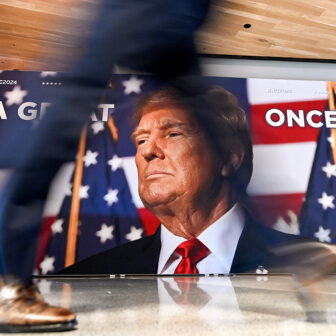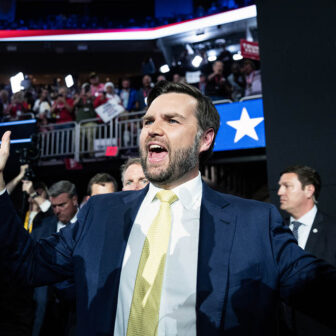When North Korea tested a ballistic missile back in February, the Trump administration threatened military action. It did the same thing when Pyongyang tested again on 4 July. But each time, after a few days of rising anxiety, the tough talk evaporated. Washington went back to the same old measures — sanctions and UN Security Council resolutions — that have so plainly failed to stop North Korea’s nuclear and missile programs for so long.
This approach leaves North Korea’s weapons program intact and steadily growing, raising the prospect that America will have to learn to live with a nuclear-armed North Korea, as the US Pacific Naval Commander, Admiral Scott Swift, perhaps unintentionally acknowledged last week. Worse, it leaves America’s strategic credibility seriously weakened — and that has implications far beyond the North Korean nuclear issue itself. A decline in the United States’ authority in Asia erodes the entire regional order and helps to reinforce China’s challenge to US leadership.
Credibility matters so much because the leading position of the United States in Asia has depended ultimately on the belief, among allies and potential adversaries alike, that it is both willing and able to defend its interests and fulfil its commitments by force if need be. It is the strength of that belief that has made the actual use of force unnecessary, because no one has doubted what the outcome of a military confrontation would be.
But doubts grow every time the United States threatens military action and then fails to follow through. Allies increasingly fear, and rivals increasingly hope, that Washington will not stand by its commitments in a crisis. As that happens, US leadership erodes, and in Asia today that means Beijing’s bid to build a new Chinese-led order moves ahead.
So Washington needs to stop making these empty threats. It must either resolve to use armed force to destroy North Korea’s nuclear and missile programs, or it must learn to live with them.
The problem with using force is that no credible military options exist. There is no reasonable chance of destroying or even significantly degrading North Korea’s weapons programs without provoking a major war on the Korean peninsula, with a very grave risk that nuclear weapons would be used.
That’s because there is no quick, cheap “surgical strike” option. Two stark realities confront any idea of a limited series of precisely targeted strikes to destroy the critical elements of Pyongyang’s nuclear and missile programs.
First, there is no reliable intelligence on the locations of many of the key facilities, so it is impossible to know what to hit. Second, many of them are deeply buried in tunnels and thus impossible to destroy, even if they could be found.
Any limited-strike campaign would thus have little chance of significantly degrading, let alone eliminating, Pyongyang’s weapons programs. Moreover, it would certainly provoke major retaliation by the North against South Korean, Japanese and US targets.
And that would leave Washington with a tough choice about how to respond to such retaliation. To do nothing would look weak, but to counter-retaliate would risk a spiral of escalation leading swiftly to full-scale conflict.
So the problems with using force are clear. The problem with not using force is that nothing else seems at all likely to curtail North Korea’s nuclear and missile programs. Trump has looked to Beijing to use its unique position as Pyongyang’s major trading partner to impose the kind of devastating economic pressure that alone seems likely to bring Kim Jong-un to heel.
But China has no intention of doing that. The most obvious reason is that economic pressure strong enough to force Kim to back down would also be strong enough to risk the collapse of his regime, and Beijing does not want to deal with the resulting chaos.
The deeper reason is that the current situation works to Beijing’s advantage. Of course, China would much prefer that Pyongyang did not have nuclear weapons, but it seems willing to live with them, confident that its own nuclear forces will deter any North Korean attack against it. And, more importantly, the North’s growing nuclear forces serve China’s interests precisely because they pose such an insoluble strategic problem for the United States.
In the ruthless zero-sum contest for strategic primacy in Asia, Beijing wins when Washington’s inability to disarm North Korea makes it look weak.
This is especially true now that the North seems on the threshold of developing an intercontinental ballistic missile, or ICBM, that could mount a nuclear attack on the United States itself. A North Korean ICBM poses no new threat to China, because it is already within reach of the North’s shorter-range missiles, but it fundamentally transforms the risks for the United States.
The danger for Washington is not just that Kim Jong-un might order an unprovoked attack on US cities — the certainty of massive nuclear retaliation makes that extremely unlikely. More importantly, Pyongyang’s ability to target the United States undermines the confidence of US allies like South Korea and Japan that Washington would be willing and able to protect them from Pyongyang’s nuclear threats.
And that uncertainty serves Beijing’s interests. It undermines these critical US alliances that are central to the United States’ strategic position in Asia, and correspondingly advances China’s bid to replace the United States as Asia’s leading power. It is thus very unlikely that China will do much to help the United States solve its North Korea problem.
All this shows the depth and complexity of the strategic challenges facing the United States in Asia today. They will only be made worse by the kind of empty bluffing we have seen so far from the Trump administration.
A much more considered policy is needed. And that must start with a fundamental re-examination of US aims and objectives in Asia, and a coldly realistic assessment of the costs and risks that they would entail. •




